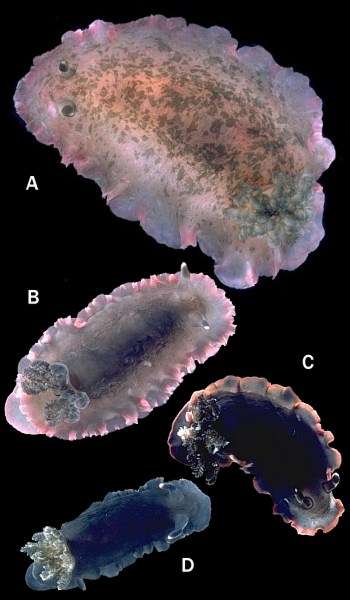
Dendrodoris fumata
(Ruppell & Leuckart, 1831)
Order: NUDIBRANCHIA
Suborder: DORIDINA
Family: Dendrodorididae
DISTRIBUTION
Tropical to warm temperate Indo-West Pacific.
PHOTO
TO RIGHT:
A. 99mm long, Darwin, Northern Territory, Australia, June 1987, (C153598)
B. 32mm long, White Horse Point, Balmain, Sydney, April 1981, (C127569).
C. 58mm long, Eyre Peninsula, South Australia, February 1985, (C145117).
D. 27mm long juvenile, White Horse Point, Balmain, Sydney, April 1981, (C127569).
LOWER PHOTOS:
E. 39mm long, Koumac, New Caledonia, October 1993, (C200506)
F. 48mm long, Koumac, New Caledonia, October 1993, (C200449).
G.33mm long, Darwin, Northern Territory, Australia, June 1987, (C153616).
H. 35mm long, North Coast New South Wales, March 1982, (C132943)
I. 8mm long juvenile, Noumea, New Caledonia, October 1988, (C156674).
J. 48mm long, under stones, Breakwater near wharf, Zanzibar, Tanzania, July 1971.
PHOTOS: BILL RUDMAN.
This species and Dendrodoris nigra both have a similar range of colour forms, often red, pink, or reddish orange when juvenile, but black when adult. It is difficult to correctly identify all the published references to these two species. The differences between the two species is discussed under Dendrodoris nigra. Two external features of Dendrodoris fumata which seem to be absent from Dendrodoris nigra are the 5 or 6 large branching gills which often spread from one side of the mantle to the other, and the small papillae on the skin of the mantle, which are usually black (Photos H,I). Sometimes these papillae are only slightly raised but in other specimens they can be quite long (1-2mm). Dendrodoris fumata often has large blackish patches on a lighter background, but unfortunately this is not exclusive to this species.
Reference:
• Ruppell, W.P.E.S. & Leuckart, F.S. (1831 for 1828). Mollusca. In Atlas zu der Reise im nördlichen Afrika von Eduard Rüppell Zool. Neue wirbellose Thiere des Rothen Meers: 15-47, pls. 1-12
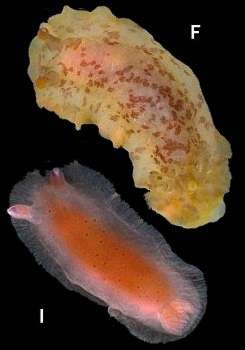
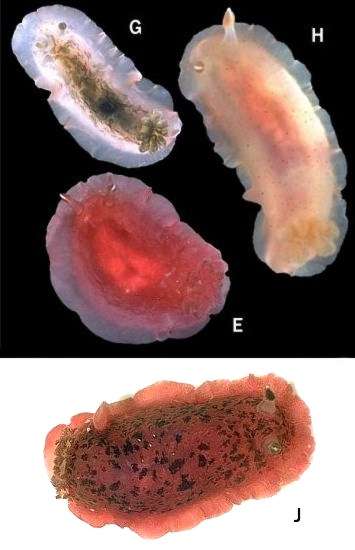
Rudman, W.B., 1999 (August 16) Dendrodoris fumata (Ruppell & Leuckart, 1831). [In] Sea Slug Forum. Australian Museum, Sydney. Available from http://www.seaslugforum.net/find/dendfuma
Related messages
Dendrodoris fumata from sthn Queensland
May 8, 2009
From: Gary Cobb
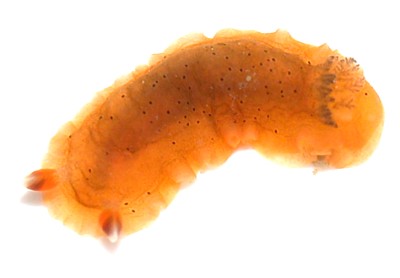
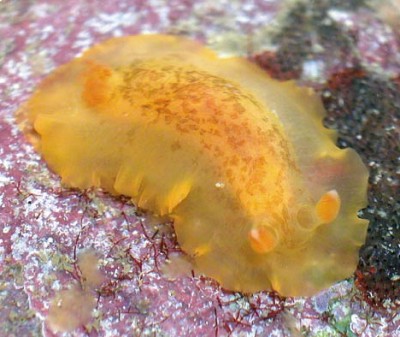
Concerning message #22374:
Hi Bill and everyone!
Here is a record of Dendrodoris fumata from sthn Queensland. This species is found both intertidally and subtidally but always from under rocks during the day. It seems that this species is a bit varied in it's colouration.
Locality: Mooloolaba, Sunshine Coast, 10mm - 12m, Queensland, Australia, Pacific Ocean, 24 July 2008, Subtidal and Intertidal. Length: 9 - 80mm. Photographer: Gary Cobb.
Cheers
Gary Cobb
gary@nudibranch.com.au
Cobb, G.C., 2009 (May 8) Dendrodoris fumata from sthn Queensland. [Message in] Sea Slug Forum. Australian Museum, Sydney. Available from http://www.seaslugforum.net/find/22406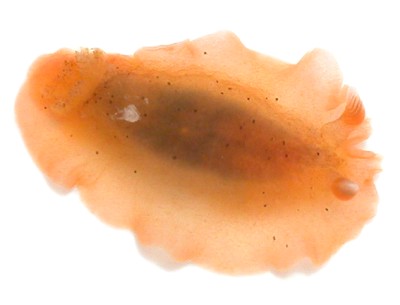
Dear Gary,
Yes D. fumata shows a considerable range in colour variability. Unfortunately, as I am sure you know, another species of Dendrodoris, D. nigra, has an almost identical colour range, making the identification of juveniles almost impossible.
Best wishes,
Bill Rudman
Dendrodoris fumata or D. nigra?
April 1, 2009
From: Apte Deepak
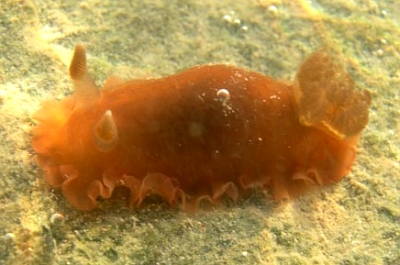
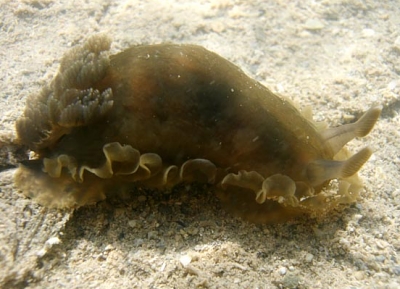
Concerning message #21797:
Dear Dr. Bill
Is the attached image of Dendrodoris nigra or D. fumata?
Locality: Gulf of Kutch, exposed reef, Gujarat, India, Arabian Sea, 27 March 2009, Mud dominated reef. Length: 50 to 60 mm. Photographer: Deepak Apte.
Deepak Apte
spiderconch@gmail.com
Apte D.A., 2009 (Apr 1) Dendrodoris fumata or D. nigra?. [Message in] Sea Slug Forum. Australian Museum, Sydney. Available from http://www.seaslugforum.net/find/22374Dear Deepak,
These are both D. fumata. From the Fact Sheets for both species, you will see that they have much the same range of colour variation. The simplest way of separating them is to look at the extended gills. D. fumata has about 5 large spreading gills while D. nigra has 10 or more short gills which stand quite upright. Of course if you have photos only and the gills are not extended this character is a problem. You can see the large spreading gills in the black animal. In the reddish animal, the gills appear to be only partially extended which fits with D. fumata.
Best wishes,
Bill Rudman
Dendrodoris fumata from the Red Sea
August 25, 2008
From: Sylvain Le Bris
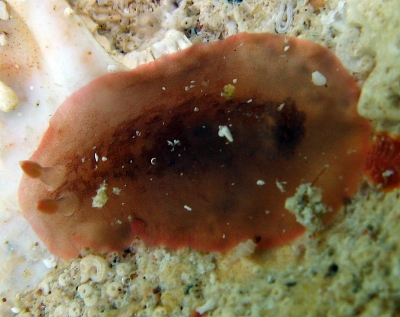
Dear Bill,
Another dorid that I could nor successfully identify. I need your help one more time.
Locality: Marsa Nakari, 1 m, Egypt, Red Sea, 17 July 2008. Length: 2.5 cm. Photographer: Sylvain Le Bris.
Found under rocks on the top of the reef.
Regards
Sylvain
lebris.sylvain@gmail.com
Le Bris, S., 2008 (Aug 25) Dendrodoris fumata from the Red Sea. [Message in] Sea Slug Forum. Australian Museum, Sydney. Available from http://www.seaslugforum.net/find/21797Dear Sylvain,
This is a reddish form of the very variable Dendrodoris fumata.
Best wishes,
Bill Rudman
Re: Dendrodoris egg mass and larval details
September 8, 2007
From: Gilianne Brodie
Concerning message #20544:
Hi Bill
following up a little on your stated need for looking at larval and egg mass details for separating some species of Dendrodoris. I agree and there is a manuscript in the Perth Congress symposium volume (recently published by the WA Museum) that starts the ball rolling!
Best wishes
Gilianne
brodie_g@usp.ac.fj
Brodie, G.D., 2007 (Sep 8) Re: Dendrodoris egg mass and larval details. [Message in] Sea Slug Forum. Australian Museum, Sydney. Available from http://www.seaslugforum.net/find/20662Dear Gilianne,
That's why I referred to your paper in a recent message [#20153]. Unfortunately I feel uncomfortable using many of the studies prior to your work because it's impossible to accurately re-identify the species that the eggs and embryos came from.
-
Brodie, G.D. & Calado, G. 2006. Dendrodoris arborescens (Collingwood, 1881) (Mollusca: Nudirbanchia): larval characterstics reveal a masked porostome species. Records of the Western Australian Museum Suppl. 69: 119-126.
Best wishes,
Bill Rudman
Dendrodoris fumata? from the Seychelles
September 6, 2007
From: David K A Barnes
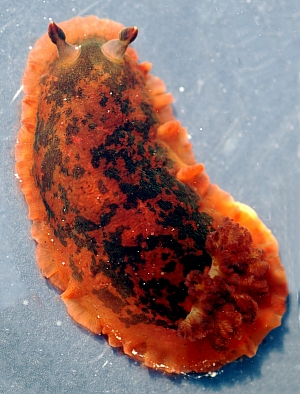
Three pics of this orange/red sea slug taken on the lower shore in rock/sand/reef habitat. Does anyone know what it might be, sorry no specimen.
Locality: Silhouette Is, Intertidal, Seychelles, Indian, August 2007, Rock and sand with some coral. Length: ~4cm. Photographer: Richard Barnes.
Richard Barnes
dkab@bas.ac.uk
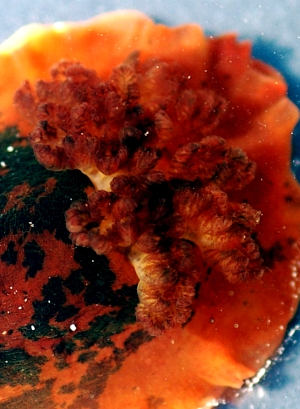
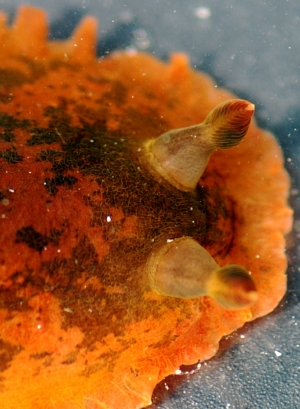
Dear Dave,
This is a species of Dendrodoris which used to be known as Dendrodoris rubra Kelaart 1858 but has more recently been considered a red colour form of Dendrodoris fumata. I have a photo of a specimen almost identical to yours from Zanzibar on the D. fumata Fact Sheet. If you also look at the Dendrodoris nigra Fact Sheet you will see that both species have a similar range of colour forms and both usually are red as juveniles. I must say I am beginning to wonder if we have gone to far with lumping all these colour forms into two species, but as species of Dendrodoris lack radular teeth, which are quite valuable in species differentiation, its going to be a painstaking job working out how many of these red and black species there are. It would be very valuable if we had a better idea of their egg ribbons and larval development as the little we do have suggests there are differences. The main problem is is linking these reproductive differences to identifiable animals.
Best wishes,
Bill Rudman
Dendrodoris fumata? from Western Australia
August 11, 2007
From: Bruce Potter
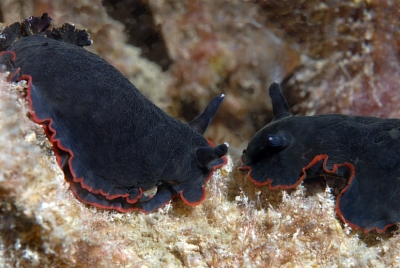
Dear Bill,
I recently photographed the acompanying two Dendrodoris fumata under a jetty near Rockingham in Western Australia. Nearby I found the third slug which puzzled me. I then found out that D. fumata comes in a variety of colours. This orange one was the same size as the pair of black ones, but is is possible that it is a colour form of D. fumata?
All three slugs were about 40 mm long and found at 6 to 7 meters depth.
Locality: Rockingham, 7 meters, Western Australia, Indian Ocean, 05 April 2007, silty, under a jetty. Length: 40 mm. Photographer: Bruce Potter.
Regards
Bruce Potter
bandppotter@bigpond.com
Potter, B., 2007 (Aug 11) Dendrodoris fumata? from Western Australia. [Message in] Sea Slug Forum. Australian Museum, Sydney. Available from http://www.seaslugforum.net/find/20153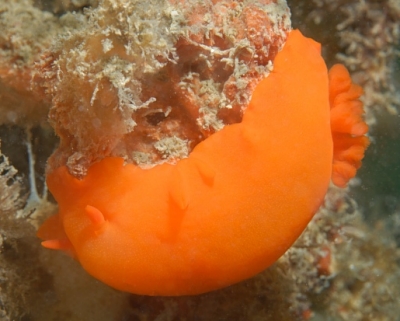
Dear Bruce,
Unfortunately I wasn't able to attend the Malacological Congress in Perth (July 2004) so its only recently that I have had a chance to see the contributions which have now been published. One of these, by Brodie & Calado, (2006) propose that this black form of Dendrodoris should be considered a separate species Dendrodoris arborescens (Collingwood, 1881). I haven't had a chance to read the paper fully but I suspect I will have to go through the D. fumata messages in the near future and sort them out.
Concerning your bright orange animal, it is a bit hard to be sure, but it could be either D. fumata or D. nigra. It really depends on the gills. if you have another photo showing them more clearly it would be helpful. If it is D. nigra there should be many quite small gills, while if it is D. fumata there should be five or size large bushy gills.
-
Brodie, G.D. & Calado, G. 2006. Dendrodoris arborescens (Collingwood, 1881) (Mollusca: Nudirbanchia): larval charcterstics reveal a masked porostome species. Records of the Western Australian Museum Suppl. 69: 119-126.
Best wishes,
Bill Rudman
Re: Colour forms of Dendrodoris fumata from Reunion
May 19, 2007
From: Philip Cromwell
Concerning message #19902:
Dear Bill and Hugues,
I've seen a similar phenomenon occur in sea anemones when there was a major change in salinity. Is it possible that there was fresh water entering the pool near the slug?
Cheers,
Phil
chiron42@sbcglobal.net
Cromwell, P. A., 2007 (May 19) Re: Colour forms of Dendrodoris fumata from Reunion. [Message in] Sea Slug Forum. Australian Museum, Sydney. Available from http://www.seaslugforum.net/find/19920Colour forms of Dendrodoris fumata from Reunion
May 16, 2007
From: Hugues Flodrops
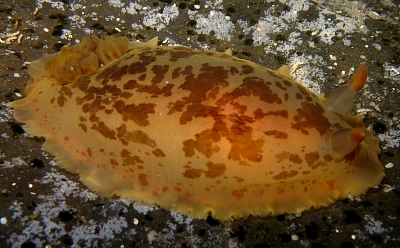
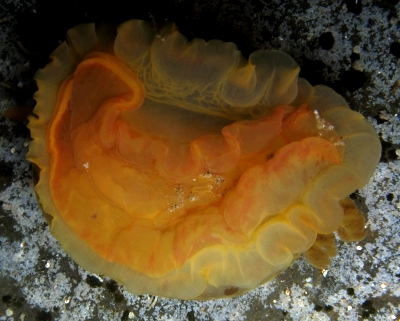
Dear Bill,
Here are probably two specimens of Dendrodoris fumata from Etang-Salé Rocky coast. The biggest [upper 2 photos], size about 85 mm, was found during the night of 16 April 2007 and it's looks like to your number A.
Locality: Etang-Salé, 1 metre and surface, Reunion Island, Indian Ocean, 16 april and 5 may 2007, By night. Length: 85 and 60 mm . Photographer: Hugues Flodrops.
The second [lower photo ] was found in the same pool, near surface (butterfly reflection) during another night: 5 May 2007. It's size about 60-65 mm. We can see a sphere at the end of the gills, what it is? Intestine expelled!
Thanks again.
Regards.
Hugues.
hugues.flodrops@wanadoo.fr
Flodrops, H., 2007 (May 16) Colour forms of Dendrodoris fumata from Reunion. [Message in] Sea Slug Forum. Australian Museum, Sydney. Available from http://www.seaslugforum.net/find/19902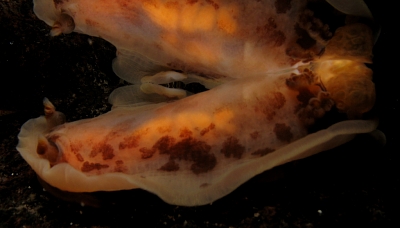
Dear Hugues,
Yes these are a pale colour form of D. fumata. Certainly the swollen sac emerging from the centre of the gills in the lower animal suggests a major 'health' problem. Often when these animals are dying, some rotting occurs internally - even while the body wall muscles are still working - and as pressure builds up internally the anal opening is the weakest point - not a pretty picture.
Best wishes,
Bill Rudman
Dendrodoris fumata from Western Australia
April 19, 2007
From: Bruce Potter
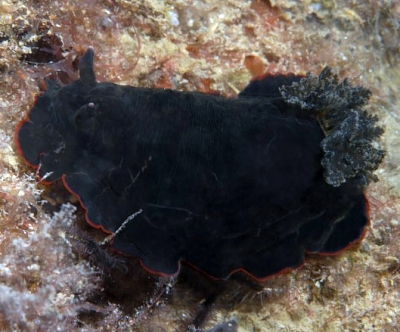
Dear Bill,
I found this large black critter under the jetty at Rockingham and have decided it isDendrodoris nigra . Being totally black, apart from its gills, made it very difficult to photograph. I had trouble getting any detail. It did have slight markings on the body and a red marginal line.
It would have been about 45mm long and was at about 6 metres deep.
Locality: Rockingham, 6 metres, Western Australia, Indian Ocean, 24 February 2007, Mucky under Jetty. Length: 45mm. Photographer: Bruce Potter.
Regards
Bruce Potter.
bandppotter@bigpond.com
Potter, B., 2007 (Apr 19) Dendrodoris fumata from Western Australia. [Message in] Sea Slug Forum. Australian Museum, Sydney. Available from http://www.seaslugforum.net/find/19605Dear Bruce,
As you will have seen from the Fact Sheets, these black dendrodorids are difficult to distinguish - and its possible there is a third or more species lurking in the mix. Your animal is probably D. fumata because it has about 5 large feathery gills. In D. nigra the gills are smaller and much more numerous.
Best wishes,
Bill Rudman
Dendrodoris fumata from the Swan River, Western Australia
February 15, 2007
From: Brent Murdoch
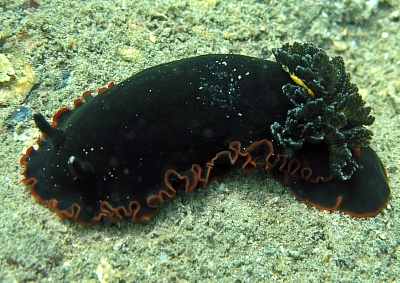
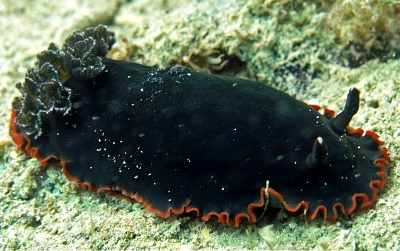
Hi Bill,
I am not sure if I have identified this one correctly. It looks the same as the NW Aphelodoris but it was in the Swan River, Fremantle, Western Australia, Indian Ocean
It was on a muddy bottom at 13 m. 65 mm long, 1 February, 2007. They seem to be quite common as I have seen a few on this dive.
Brent Murdoch.
brent@murdoch.id.au
Murdoch, B., 2007 (Feb 15) Dendrodoris fumata from the Swan River, Western Australia. [Message in] Sea Slug Forum. Australian Museum, Sydney. Available from http://www.seaslugforum.net/find/19427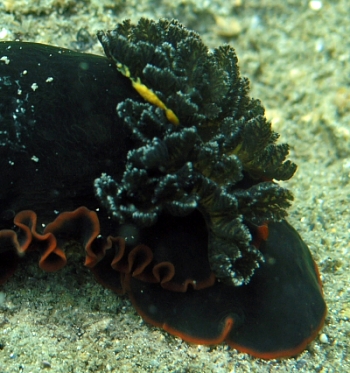
Dear Brent,
Although in many ways it has similarities to Aphelodoris gigas, which was recently described from Western Australia, your animal the suctorial sponge-feeding dendrodorid, Dendrodoris fumata. It is very similar to forms of D. nigra, but in that species there are 10 -15 small gills forming a cup-shaped circle around the anal papilla, while in D. fumata there are a few [5? 6?] large gills which expand out to cover the posterior half of the body. The thin yellow 'cylinder' you can see at the front of the gills is the faecal string which has been expelled from the anus. From its colour we can be prety sure it has been eating a yellow sponge - probably the one we can see the left side of the top photo.
Best wishes,
Bill Rudman
Dendrodoris fumata from sthn Queensland
October 27, 2006
From: Michelle Wilcox
Concerning message #5098:
Hi there,
I was checking through your site to identify a small slug I saw at Wellington Point (near Brisbane), Queensland at lowtide on the mud/coral rubble flat.
Locality: Wellington Point, Brisbane, Maybe a metre or more, when the tide's in, QLD, Australia, Pacific Ocean, 23 September 2006, On weed/coral rubble at lowtide. Length: 12-15mm
It was about 12-15mm in size and looked identical to the photos in the article "Dendrodoris arborescens from Japan" so I am guessing its D. fumata, from what you say.
There was a 'feathery' 5-point star shaped gill on its bottom. Can you confirm this species is found in South-East Queensland?
I also saw the photos of this species' yellow egg clusters. I saw one of those also, on the same day, and thought it just snail eggs, but now I know better now.
Cheers
Michelle
suspicion_belle@hotmail.com
Wilcox, M., 2006 (Oct 27) Dendrodoris fumata from sthn Queensland. [Message in] Sea Slug Forum. Australian Museum, Sydney. Available from http://www.seaslugforum.net/find/17943Dear Michelle,
It sounds as though your slug is Dendrodoris fumata, which can be found all around the coast of Australia.
Best wishes,
Bill Rudman
Dendrodoris fumata from Singapore
June 16, 2006
From: Ron Yeo
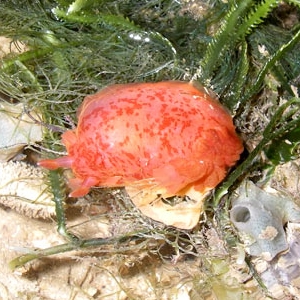
Hi,
I'm a nature volunteer from Singapore. Found this nudibranch at Chek Jawa, an intertidal flat on an island called Pulau Ubin.
Looks like it is laying egs.
Locality: Chek Jawa, Pulau Ubin, Singapore, 30 cm, Singapore, Strait of Johor, 11 June 2006, Intertidal. Length: 4 cm. Photographer: Ron Yeo.
Would really appreciate it if you can assist to identify it.
Thanks,
Ron Yeo
ronyeo@bigfoot.com
Yeo, R, 2006 (Jun 16) Dendrodoris fumata from Singapore. [Message in] Sea Slug Forum. Australian Museum, Sydney. Available from http://www.seaslugforum.net/find/16876Dear Ron,
It certainly looks like it is laying eggs. I am pretty sure this is one of the colour varieties of Dendrodoris fumata. This species is often red as a juvenile and black as an adult, but often some animals stay red as they mature. Another species, Dendrodoris nigra, has a similar colour change, but it does not have this dark mottling on the mantle as in your animal.
Best wishes,
Bill Rudman
Mystery slug in aquarium
May 27, 2006
From: Kevin Yang
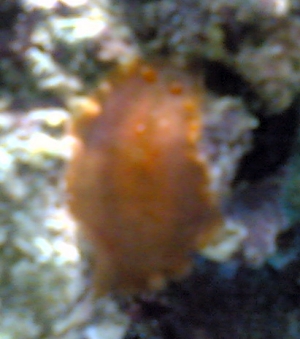
Dear Sir,
I have had my tank with the live rocks for about one month now. One night, when i turned on the lights i discovered a slug crawling on my rock and photographed it. The slug must have come in hidden inside the live rocks that i bought.
Do not know much about slugs. I have fishes, shrimps as well as corals in the tank. Should i try to remove the slug and give it back to the retailers or is it alright to leave it in the tank.
I have gotten some pictures of it....what type is it? If i leave it in the tank, how should i care for it? Length: 4.5 cm
Thanking you in advance for your advice.
Kevin Yang
Singapore
kevin@starglobal.com.sg
Yang K, 2006 (May 27) Mystery slug in aquarium. [Message in] Sea Slug Forum. Australian Museum, Sydney. Available from http://www.seaslugforum.net/find/16680Dear Yang,
This is a species of Dendrodoris. It is most probably Dendrodoris fumata but could be D. nigra. Both species are quite commonly introduced into aquaria on 'live rock'. They can squeeze into small crevices and so are protected from drying out and being squashed when the rock is being transported. We dont know much about the actual sponges these species feed on but I assume they must be sponges that are fairly hardy, reasonably common, and can live, like the slug in small crevices. Sometimes the slugs seem to appear months after the 'live rock' has been put into the aquarium so it is unlikely the slug has been starving all that time.
I don't know of any evidence that species of Dendrodoris can harm other occupants of your tank so you might as well leave it in your aquarium as there is no guarantee the retailer will have the right sponge to feed it. Many nudibranchs only appear at night. This is one way they have of avoiding been eaten by fish, which only hunt during the day
Best wishes,
Bill Rudman
Which nudibranch do I have ?
May 29, 2003
From: Richard Andrews
I am setting up a marine aquarium and have bought some live rock to help with setup. After the last lot of rock that I purchased its seems that I got a couple of hitch hikers. I have a small black nudibranch with a bright pink outline and antennae. Also have a light green that seems to be eating some algae off the glass. I was wondering if it was at all possible to work out which nudibranch the black one is so that I know who its predators are so that I don't buy them and what food it eats.
Richard Andrews
richard.andrews@NRMA.com.au
Andrews, R., 2003 (May 29) Which nudibranch do I have ?. [Message in] Sea Slug Forum. Australian Museum, Sydney. Available from http://www.seaslugforum.net/find/9956Dear Richard,
I suspect the black one is Dendrodoris fumata. If you go to that page and look at earlier messages you will see that we are still not sure which sponges it feeds on so the likelihood is that it will starve aftyer it eats out any suitable sponge it has found on your 'live rock'.
Best wishes,
Bill Rudman
Re: Ken Ashman's Dendrodoris (1)
April 24, 2003
From: Jun Imamoto

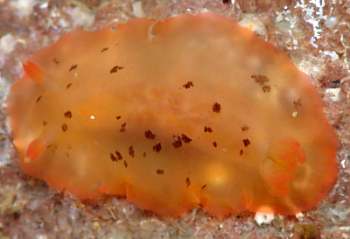
Dear Bill,
When I saw Bruce Wight's photo of Dendrodoris from California, its form and a pattern reminded me of an animal I have found here in Japan - but the bakground colour is really different.
The animal in my photos from Sagami Bay are orange, and it was found under a rock with an orange sponge. Perhaps there is some relationship between the colour of the animal and its food sponge. I thought this animal was a colour form of Dendrodoris fumata until now.
Manazuru, Sagami Bay, Japan
size approx: 10 mm, Intertidal.
Temp: 23 C, 19 Oct 2002.
Photos: Jun Imamoto
I would be very happy if I could hear your comment. I have posted further photos in a separate message.
Best Regards,
Jun Imamoto
http://umiushi.zive.net/
imamoto@wips.co.jp
Dear Jun,
This is certainly Dendrodoris fumata. As I have illustrated on the species Fact Sheet, this is a highly variable species. There are a group of species worldwide which have black patches on the mantle. I am not sure if that means they are related or whether it is a coincidence. Considering that there are species which range from California, around the northern Pacific to Japan, a connection between the the black-spotted Japanese D. fumata and the Californian Dendrodoris sp. 4 certainly needs to be considered.
Your red animals are all quite small. Both D. fumata and D. nigra have a red juvenile colour form. I am not sure if it related to their food sponge, simply beause we don't know enough about their food preferences.
Best wishes,
Bill Rudman
Re: Ken Ashman's Dendrodoris (2)
April 24, 2003
From: Jun Imamoto
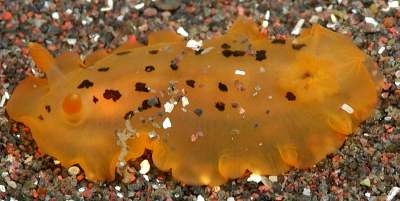
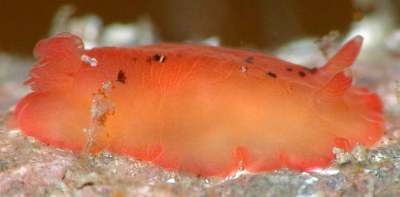
Dear Bill,
Here are photos of two more black-spotted specimens to accompany my other message.
Upper Photo:
Osezaki, Suruga Bay, Japan, Depth: 8 m - crawling on sand at night. Length pprox: 14 mm. Temp: 17 C. 9 Nov 2002. Photo: Jun Imamoto
Lower Photos:
Manazuru, Sagami Bay, Japan, Intertidal. Length approx: 7 mm. Temp: 23 C. 19 Oct 2002.
Photos: Jun Imamoto
Best Regards,
Jun Imamoto
imamoto@wips.co.jp
Imamoto, J., 2003 (Apr 24) Re: Ken Ashman's Dendrodoris (2). [Message in] Sea Slug Forum. Australian Museum, Sydney. Available from http://www.seaslugforum.net/find/9723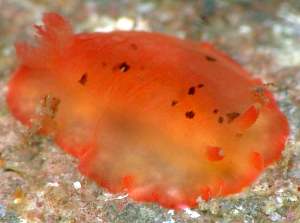
Thanks Jun,
I guess its not a very big sample but the three animals in this message and your other message show a change in colour from red to yellow from the smallest to the largest, which fits the idea I mention in your other message that juvenile D. fumata are red but change colour as they grow older. It would be interesting to see a larger series of photos to see if this is the general rule.
Best wishes,
Bill Rudman
Dendrodoris fumata - egg ribbon
March 20, 2003
From: Rachel Przeslawski
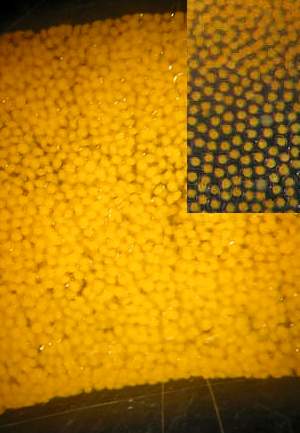
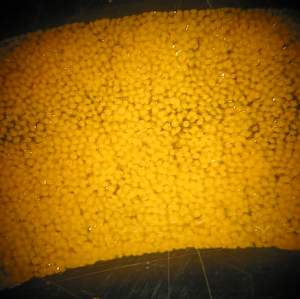
Hi Bill,
Here's the information on the Dendrodoris egg masses you asked about. Unfortunately the quality of some of the photos is low. One set is of Dendrodoris nigra and the other is of Dendrodoris fumata. The photos in this message are of D. fumata [Note: inset in upper photo is of D. nigra for comparison]. The ones of D. nigra are in a separate message.
Both species laid in the laboratory and both laid thin upright spiral orange egg ribbons. D. nigra laid a looser "messier" spiral while D. fumata laid a neatly coiled mass. D. nigra had a wider egg ribbon (5.5-6mm) than D. fumata (3-5mm) although this is likely variable considering only 3 egg masses were examined. D. fumata had a much higher density of embryos very tightly packed while D. nigra [see inset] only had 2 layers of embryos in moderate density. D. nigra had larger eggs and capsules (125um, 175um ) than D. fumata (< 75um, 100um).
As with most nudibranch egg masses there was only 1 egg per capsule with occasional twins. I allowed both ribbons to hatch, and found that embryos hatched at swimming veliger stage in both. D. nigra had a very noticeable large bi-lobed velum.
Keep in mind these observations are only from 2 D. fumata and 1 D. nigra egg masses so further observations would be great to see potential variations within each species. You'll also be pleased to know that I've gotten access to a camera that has a better capacity for close-ups than the one I've been using. Hopefully you won't receive any more of these bad photos from me, but I thought it was better than nothing in this case!
Cheers
Rachel
rachelp@uow.edu.au
Przeslawski, R., 2003 (Mar 20) Dendrodoris fumata - egg ribbon. [Message in] Sea Slug Forum. Australian Museum, Sydney. Available from http://www.seaslugforum.net/find/9434Thanks Rachel,
I must say I always feel guilty when I don't take notes or photograph an egg mass of a common animal. Hopefully your information, although preliminary, will be a useful catalyst for all of us to take a closer look at such things.
Bill Rudman.
Dendrodoris fumata from Sth Korea
July 19, 2002
From: Dong Bum, Koh
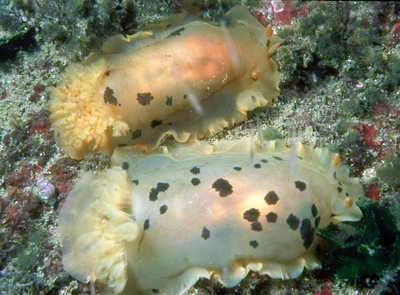
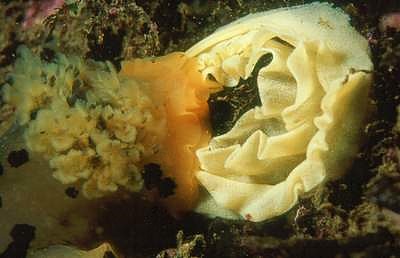
Dear Bill,
Here are two photos of Dendrodoris rubra & its egg ribbons for the Forum.
They were taken at the same time & place.
Northern coast of CheJu Island (near CheJu city) Sth Korea, 6m depth on a night dive. Sep. 2001. Photos: Dong Bum,Koh
Best wishes,
Dong Bum, Koh
drkoh@seasee.co.kr
Koh, D.B., 2002 (Jul 19) Dendrodoris fumata from Sth Korea. [Message in] Sea Slug Forum. Australian Museum, Sydney. Available from http://www.seaslugforum.net/find/7516Thanks Dong Bum,
This species is considered to be a form of Dendrodoris fumata. Animals that used to be identified as Dendrodoris rubra were either red forms of D. fumata or of Dendrodoris nigra, both species having a similar range of colour varieties,
Best wishes,
Bill Rudman
Dendrodoris fumata? from Christmas Island
May 17, 2002
From: W.B. Rudman

Here is a photo of an animal I have tentatively identified as Dendrodoris fumata ? from John Hicks' Christmas Island, Indian Ocean collections.
PHOTO: AM C130154, 45 mm long alive, 11 June 1981, off the Cinema, 10m, under rock, near black sponge, Christmas Is., Indian Ocean. Photo: John Hicks
Best wishes,
Bill Rudman
Re: Dendrodoris fumata in Japan
September 13, 2001
From: Jun Imamoto
Dear Bill
Thank you for your comments. Unfortunately I couldn't find an egg ribbon. But since you say that the type of egg ribbon is important in distinguishing the kind of sea slug, we will from now on look for them as well.
Thank you very much.
Best Regards,
Jun Imamoto
imamoto@wips.co.jp
Imamoto, J., 2001 (Sep 13) Re: Dendrodoris fumata in Japan. [Message in] Sea Slug Forum. Australian Museum, Sydney. Available from http://www.seaslugforum.net/find/5228Dear Jun,
It is certainly a good idea to look for egg ribbons but unless you can actually see an animal laying a ribbon you can't be sure who the eggs belong to. Apart from helping distinguish different species, eggs are often a very good way of knowing that cryptic (hard to see) nudibranchs are nearby, because often the egg ribbon is much easier to see than the adult slug. When looking for nudibranchs on bryozoans, hydroids, soft corals etc it is always useful to do a quick scan for eggs as an indicator that adults are nearby,
best wishes,
Bill Rudman
Dendrodoris fumata? from Japan
September 6, 2001
From: Jun Imamoto
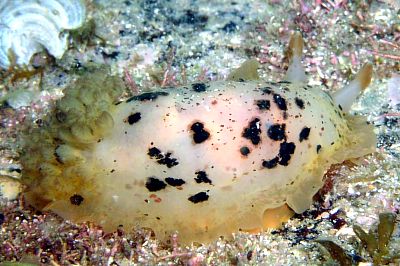
Dear Bill
I had a look at your comments on Dendrodoris nigra and Dendrodoris fumata. It was easy to understand your English writings. Thank you very much.
I have attached photos I consider to be Dendrodoris fumata. They were photographed at the same place as my earlier photos.
Place: Echizen coast (Tsuruga Bay, Japan); Depth: 1m; Size: 40-50mm; Water temperature: 28C degrees.
They are common sea slugs there, but I am happy if those are helpful for you.
Best Regards,
Jun Imamoto
imamoto@wips.co.jp
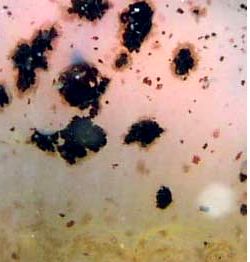
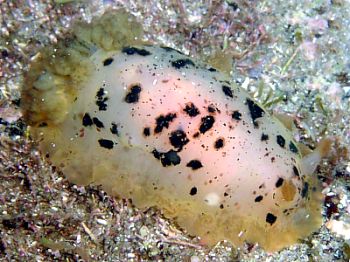
Dear Jun,
Yes I would consider these to be Dendrodoris fumata, but I have not seen this colour form from anywhere else. I sometimes wonder if there is more than one species involved. Do you find the white ones with black spots together with the black ones or are they always in separate groups? Like I have suggested for some of the variable species of Chromodoris, it might be interesting to see if they all lay the same sort of egg ribbon. Even if the egg ribbon is the same shape it is possible that the size of the eggs may be different. I wouldn't expect you to try measuring the diameter of each egg but a reasonably closeup photo of the egg ribbon should give us enough detail to see whether the eggs are very small or very large.
Best wishes,
Bill Rudman
Dendrodoris arborescens from Japan
August 23, 2001
From: Jun Imamoto
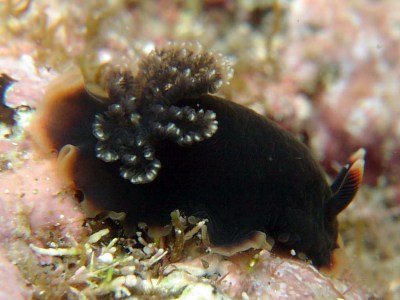
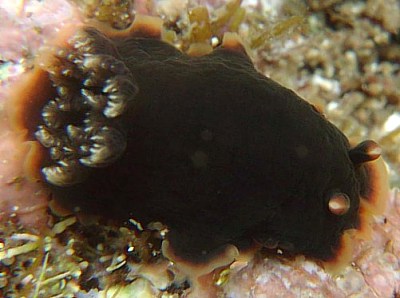
Dear Bill
I went to Echizen (Tsuruga Bay, Japan) from August 11, 2001 to August 12, 2001.
I filmed a Dendrodoris arborescens and have attached two of my photo.
They were found at 2M depth and were all around 10mm long. Water temperature is 26-28C degrees. Those are common sea slugs there, but I am happy if those are helpful for you.
Best Regards,
Jun Imamoto
imamoto@wips.co.jp
Imamoto, J., 2001 (Aug 23) Dendrodoris arborescens from Japan. [Message in] Sea Slug Forum. Australian Museum, Sydney. Available from http://www.seaslugforum.net/find/5098Dear Jun,
Thanks for these photos. It is very useful to see all the Japanese colour forms of some of these widespread species. This animal has often been identified in Japan and China as Dendrodoris arborescens Collingwood, 1881, but that species is now considered a colour form of the widespread species Dendrodoris fumata. I have included many of the colour forms at the top of this page. As you will see from my comments about this species and Dendrodoris nigra, these two species are very variable in colour and both have very similar colour forms. One major difference is that D. fumata has 5 large bushy gills and D. nigra has many small gills which are arranged in a tight circle.
Best wishes,
Bill Rudman
Re: Dendrodoris fumata from Sydney
March 9, 2001
From: Akos Lumnitzer
Dear Bill,
Finally I have realised that I had a slight confusion of identity Re: Dendrodoris fumata. I previously thought that the species was Dendrodoris nigra, but your recent post of Erik Schloegl's photo prompted me to look at the page and...BINGO there was my suspect. Thanks for the great information source you have provided to us enthusiastic divers and other kinds of marine life enthusiasts.
Akos
dna72@softhome.net
Lumnitzer, A., 2001 (Mar 9) Re: Dendrodoris fumata from Sydney. [Message in] Sea Slug Forum. Australian Museum, Sydney. Available from http://www.seaslugforum.net/find/3931Dear Akos,
Glad to be of help. These two species of Dendrodoris with their similar range of colour variations, are not easy to separate. I think the shape, number and position of the gills are the simplest chracter to use but this can sometimes be a trap for the unwary as well. A number of specimens of Dendrodoris nigra have been illustrated in the past with very large gills, extending out far beyond the width of the animal. This species characteristically has small gills. I suspect they have been accurately drawn/ painted/ photographed with large gills because the specimen has been kept for a long period of time in a small quantity of sea water. As the water becomes warm and oxygen levels drop, the gills often expand and become quite flaccid.
Best wishes,
Bill Rudman
Dendrodoris fumata from Sydney
March 6, 2001
From: Erik Schloegl
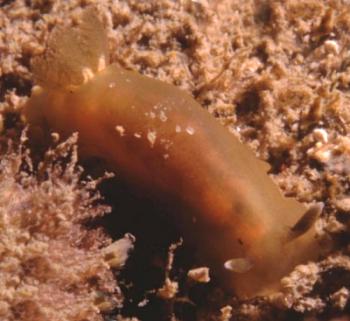
Dear Bill,
Camp Cove in Sydney Harbour [Australia] is a dive site that continues to yield nudibranch surprises - surprises to me at least, especially on dives well after sunset. The attached photo was taken on a night dive on February 24, 2000, on a rocky reef at a depth of about 4m. Can you identify the species?
Thanks,
Erik
Erik.Schlogl@uts.edu.au
Schloegl, E., 2001 (Mar 6) Dendrodoris fumata from Sydney. [Message in] Sea Slug Forum. Australian Museum, Sydney. Available from http://www.seaslugforum.net/find/3896Dear Erik,
This is a species of Dendrodoris and I suspect it is Dendrodoris fumata but sometimes in photos it is a bit hard to distinguish it from one of the colour forms of Dendrodoris nigra. However the few, relatively large gills, are characteristic of D. fumata, D. nigra having 10 or more smaller gills forming a cup-shaped circle.
Best wishes,
Bill Rudman
Dendrodoris fumata from South Australia
February 2, 2000
From: Stuart Hutchison
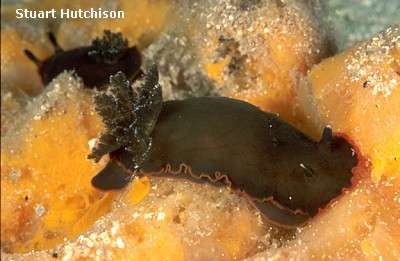
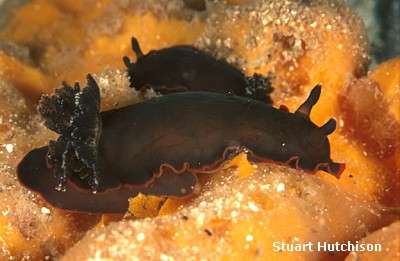
Dear Bill,
Here are some photos of Dendrodoris nigra from Edithburgh Jetty, Yorke Peninsula, South Australia in Jan 1999.
Regards,
Stuart
hutchco@tpg.com.au
Stuart Hutchison, 2000 (Feb 2) Dendrodoris fumata from South Australia. [Message in] Sea Slug Forum. Australian Museum, Sydney. Available from http://www.seaslugforum.net/find/1818Dear Stuart,
This is Dendrodoris fumata not Dendrodoris nigra. Have a look at my comments on each page to see the differences. These two species have been confusing us for over a century as both have the same range of colour forms. One good difference seems to be the shape and number of gills. In D. fumata there are a few (usually 5) large gills, which are usually extended out to the mantle edge. In D. nigra there are many small gills arranged in a cup-shaped circle.
In both your photos I think I can see parts of the bright yellow egg ribbon. It also appears that the sponge they are on is a food source.
Best wishes,
Bill Rudman.
Dendrodoris fumata
August 20, 1999
From: Betsey Hansen
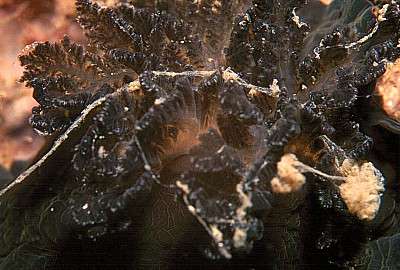
Bill,
Here is the black sea slug. I'm afraid this picture isn't very good, though. There was a lot of sediment in the water and on top of the slug.
It was taken under the pier at Clifton Gardens Beach outside of Sydney. If you haven't dove here, it's a must. I still think it was the best dive I ever did. I found 4 different sea slugs, an octopus, a cuttle fish, a dumpling squid, a lion fish, and more. I shot through two rolls of film in no time.
I will send you more sea slugs from off New York soon.
Best Wishes,
Betsey Hansen
Elizabeth.P.Hansen@chase.com
Hansen, E.P., 1999 (Aug 20) Dendrodoris fumata. [Message in] Sea Slug Forum. Australian Museum, Sydney. Available from http://www.seaslugforum.net/find/1200Dear Betsey,
It's a pretty severe test when you only send me the gills! I'm pretty sure it Dendrodoris fumata. Its black and has a few large bushy gills. There's nothing else that comes to mind around Sydney.
I must say your picture finally shamed me into finishing the pages on Dendrodoris fumata and Dendrodoris nigra. I had promised to do Dendrodoris nigra to complement the Bacteria in nudibranchs page, but couldn't do that without doing Dendrodoris fumata. And I'm afraid I was not looking forward to doing either, with all their colour forms.
Its certainly amazing that Sydney Harbour, with all its population, and at times pretty severe pollution, still contains a great diversity of marine life. This week a large pregnant Right Whale took up residence about 150 metres off Bondi Beach, and today it moved inside the harbour, perhaps to give birth, and shipping and ferries have been warned to keep clear. Although I'm more into save the snails than save the whales, I must say its an amazing sight.
And to return to something a bit smaller, I look forward to some more sea slugs from New York.
Best wishes,
Bill Rudman.
